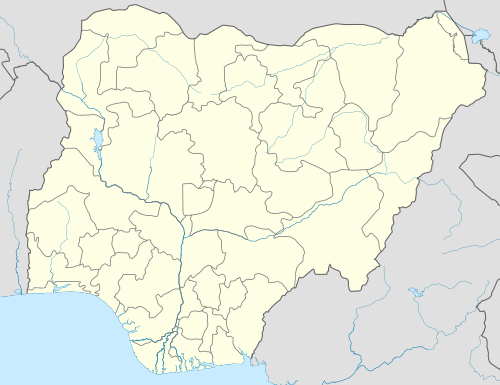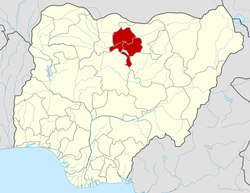Sumaila
Sumaila is a historic town and headquarters of a Local Government Area in Kano State, Northern Nigeria.
Sumaila | |
|---|---|
Town and Local Government Area | |
| Town of Sumaila | |
| Nickname(s): "Ta Sama'ila", "Masaukin Jobe" | |
| Motto(s): (A' Sumaila) | |
 Sumaila Location in Nigeria | |
| Coordinates: 11°32′N 8°58′E | |
| State | Kano State |
| Founded | 1750 |
| Settlement Status | 1750 Fulani Military Stockade, Sultanate of Kano |
| Town and District Status | 1923 Government of Northern Region, Nigeria |
| Local Government Area Status | 1982 Government of State of Kano |
| Named for | Magajin Jobe - Sama'ila |
| Government | |
| • Type | Local Government Council |
| • Chairperson Local Council | Abdullhamid Idris Rimi |
| • Speaker, Local Assembly | (interregnum) |
| Area | |
| • Town and Local Government Area | 1,250 km2 (480 sq mi) |
| • Water | 18 km2 (6.9 sq mi) 3.0% |
| • Urban | 500 km2 (200 sq mi) |
| Population (2006 Census) | |
| • Town and Local Government Area | 253,661 |
| • Density | 200/km2 (530/sq mi) |
| • Metro | 220,000 |
| Demonym(s) | Sumailan |
| Time zone | UTC+1 (WAT) |
| 3-digit postal code prefix | 712 |
| ISO 3166 code | NG.KN.SU |
History
Sumaila was established as a Jobe- Fulani 'Sansani' or Settlement in the 1740s.[1] located within the fertile plains of south eastern Kano, it provided the clan an easy migratory pathway to the grazing grounds of the savannah of eastern Hausa land. Originally called 'Garun- Sam'ila' after one of its first settlers, it attracted little attention during the time of the Sultanate,
The sharp rise of Jobe influence in eastern Kano in the late 18th century saw the construction of a stockade and a partial fort around the town in the 1750s.[2]
Sumaila rose to prominence in the time of the Caliphate when it became the site of an epic battle that halted the advance of the (Bornoan) cavalry when El-Kanemi encroached into the Sokoto Caliphate.
When during the Reign of Emir Abdullahi Maje-Karofi, the Ningi rebellion broke out, a Ribat was constructed around the town and a permanent fulani force was stationed there to protect the southern borders of the Emirate. During the Kano civil war or Basasa, Sumaila was a major hub for pan-Yusuf forces because of its close proximity to Takai; the capital of the Yusufawa.
Colonial period
Serving as a frontier fortress, the British pacification campaigns greatly affected Sumaila. In 1903, the entire Fulani military contingent of the fort under Dan-Sumaila Garba- Maje Gabas was lost in the Kano- Sokoto expedition.[1] The Last Caliph of Sokoto, Sultan Attahiru passed through the outskirts of the town attracting there from a large followership in his pilgrimage to Burmi after the fall of the Caliphate.
The fall of the Emirate witnessed a sharp decline in commerce in eastern Kano and in the 1910s, a provincial reorganization removed administration of the District's affairs to Wudil.[1] and Sumaila was relegated to sub-borough status.
In 1923 the discovery of gold reserves by a British mining expedition led to another provincial reorganization that restored District Status, political crisis however within the provinces administration and fears of the pre-federal Nigerian government then being administered from Lagos and managed by non-Northerners scuttled the mining efforts.
Post-colonial period
In 1967, the collapse of the Government of Northern Nigeria again ended the administrative independence of Sumaila, this was not to be restored until the Second Nigerian Republic when a Sumailan, Abubakar Rimi was elected Governor of Kano under the People's Redemption Party. In 1983, the collapse of the PRP government saw another momentary transference of administration to Wudil.
Subdivisions
Its subdivisions are Gala, Gani, Garfa, Gediya, Kanawa, Magami, Masu, Rimi, Rumo, Sitti and Sumaila proper.[3]
Prominent Sumailans
- Muhammadu Abubakar Rimi - politician, first Executive Governor of Kano State during the Nigerian Second Republic
- Abdullahi Aliyu Sumaila- Politician and Administrator
References
- Sumaila, Aminu A. Jobe: A Clan Compendium.
- Light, Ivan H. Ethnic Enterprise in America: Business and Welfare Among Chinese, Japanese and Blacks. ISBN 978-0520017382.
- https://www.mindat.org/feature-8633725.html
